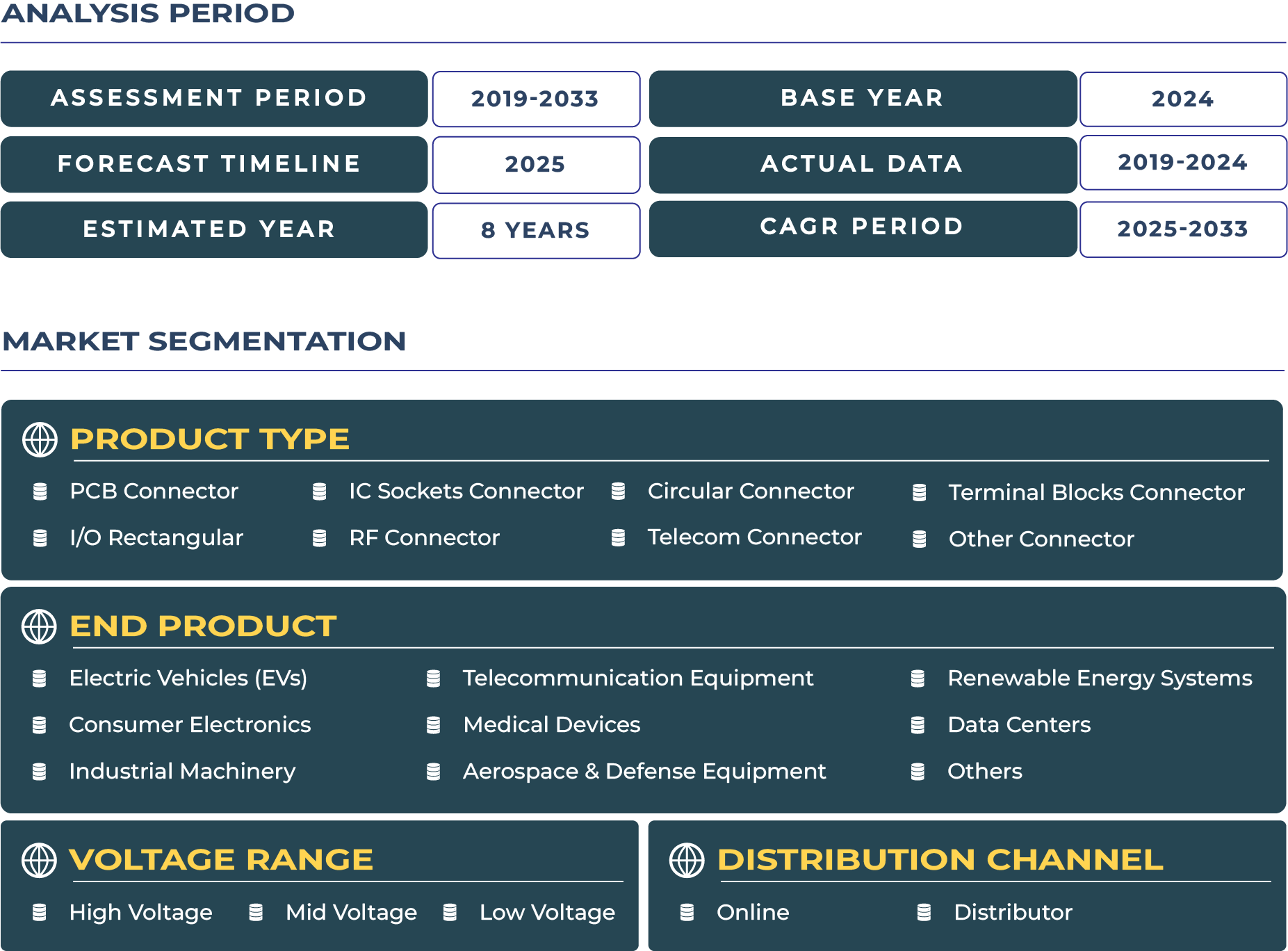Brazil Connector Market Outlook
Brazil connector market is riding a momentum few industrial segments can match: valued at USD X.2 billion in 2024 and heading toward USD X.3 billion by 2033 on a 9.1% compound annual growth rate, the sector is being pulled forward by a perfect storm of electrification, digital-first infrastructure, and generous policy tailwinds. In the opening four months of 2024 battery-electric vehicle registrations jumped an eye-catching 1,120%, lifting EV market share from 1.1% to nearly 5% and creating an instant need for high-voltage and signal-integrity connectors across traction batteries, onboard chargers, and fast-charging cables.
Automakers moving in-country are accelerating the trend: BYD’s Bahia complex—now slated for phased start-up from late 2025 with full output by 2026 after weather-related delays—will churn out up to 150,000 EVs a year and anchor a local supply-chain for precision connectors, wire harnesses, and battery-management interposers “as per the David Gomes, Manager – Semiconductor,” whose firm tracks supplier RFQs tied to the project.
Parallel to mobility, Brazil’s leap into hyperscale computing is connector-dense. Finance Minister Fernando Haddad’s 2025 tax-exemption package waives PIS, Cofins, IPI and import duties on IT gear so long as facilities run on 100% renewables. Treasury models show up to BRL 2 trillion (≈ USD 352 billion) in digital-infrastructure capex this decade, a boon for fiber-optic, high-speed board-to-board and busbar connectors used in low-latency AI clusters. Early evidence is Scala’s 54 MW “AI City” campus in Eldorado do Sul: its first-phase USD 500 million layout already specifies liquid-cooled, blind-mate connectors to cut energy loss, and expansion rights top 4.75 GW—a roadmap that could place up to 70 million connector contact points on site alone.
On the telecom front, TIM Brasil’s decision to extend Nokia’s AirScale 5G radios across 15 states from January 2025 thrusts miniature RF coax and massive-MIMO connector formats into volume production, while Nokia’s AI-driven MantaRay NMS demands ruggedized backplane terminations for edge nodes in hotter, dustier inland climates. Executive peers echo the importance: Marco Di Costanzo, CTO at TIM, tells us that each 5G macro site integrates “well over 2,000 precision contacts, and Brazil will light up thousands of sites within 24 months,” underscoring a multi-hundred-million-piece annual market.
Grid-modernization is an equally bullish narrative. With 84.6% of the country’s 209 GW installed capacity already renewable, the national target of +40,000 km in extra-high-voltage transmission by 2030 obliges utilities to adopt corrosion-resistant, vibration-proof power connectors capable of 250 kV ratings. Aneel data show 10.9 GW of new generation came online in 2024—over half solar—intensifying the need for fast-field-terminable connectors to curb curtailment losses. João Fraga, grid solutions director at WEG, notes that plug-and-play connectivity is trimming substation build times by 15%, “a saving worth millions on labor and outage penalties.”
Investor appetite is therefore brisk: cumulative venture and corporate funding into local connector startups—many leveraging bio-based polymers and smart-pin diagnostics—topped USD 220 million in 2024. Venture partner Isabel Carvalho of Gávea Tech Fund explains the thesis: “Brazil offers the rare overlap of abundant green energy, EV demand, and rapidly multiplying data flows; connectors sit at the junction of every megatrend.” Analysts expect at least three domestic IPOs in the interconnect arena by 2027, a watershed that could broaden supply resilience beyond global giants like TE Connectivity, Molex and Amphenol.
Consequently, strategic positioning now hinges on co-locating engineering support near OEM clusters in São Paulo, Minas Gerais, and Bahia; certifying products to ISO 19642 and IEC 63171 for EV and single-pair Ethernet requirements; and embedding predictive-maintenance sensing at the connector body to satisfy uptime SLAs in Tier-IV data centers. For B2B decision-makers, embedding these actions into 2025 roadmaps secures compliance, cost savings, and first-mover advantage in Latin America’s fastest-scaling connector arena.
Authors: David Gomes (Manager – Semiconductor)
*Research Methodology: This report is based on DataCube’s proprietary 3-stage forecasting model, combining primary research, secondary data triangulation, and expert validation. [
Learn more]






